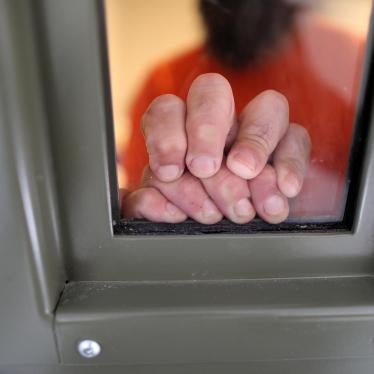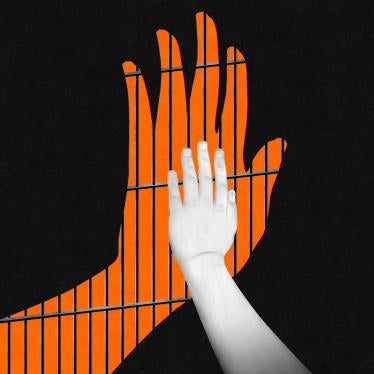March 24, 2022
Secretary Mark Ghaly
California Health & Human Services Agency
1215 O Street
Sacramento, CA 95814
Re: Human Rights Watch’s Opposition to CARE Court
Dear Secretary Ghaly:
Human Rights Watch has carefully reviewed SB 1338 and the proposed framework for the Community Assistance, Recovery and Empowerment (CARE) Court created by CalHHS.[1] In its current form, it promotes a system of involuntary, coerced treatment, enforced by an expanded judicial infrastructure, that will, in practice, simply remove unhoused people with perceived mental health conditions from the public eye without effectively addressing those mental health conditions and without meeting the urgent need for housing. We urge you to reject the proposed framework and instead to take a more holistic, rights-respecting approach to address the lack of resources for autonomy-affirming treatment options and affordable housing.
CARE Court proponents claim it will increase up-stream diversion from the criminal legal and conservatorship systems by allowing a wide range of actors to refer people with schizophrenia and other psychotic disorders to the jurisdiction of the courts without an arrest or hospitalization. In fact, the bill creates a new pathway for government officials and family members to place people under state control and take away their autonomy and liberty.[2] It applies generally to anyone perceived to have a mental health condition and substance use disorder, specifically targets unhoused people,[3] and seems aimed at facilitating removing unhoused people from public view without actually providing housing and services that will help to resolve homelessness. Given the racial demographics of California’s homeless population, this plan is likely to place many, disproportionately Black and brown, people under state control.
CARE Court is Coerced Treatment
Proponents of the plan describe CARE Court in misleading ways as “preserving self-determination,” “self-sufficiency” and “empower[ing].”[4] But CARE Court creates a state-imposed system of coerced, involuntary treatment. The proposed legislation authorizes judges to “order a person… to obtain treatment and services under a CARE plan.”[5] That treatment may include an order to take a given medication and to reside in assigned “housing.”[6] That housing could include a variety of interim housing or shelter options that may be unacceptable to an individual and unsuited to their unique needs.[7]
A person who fails to obey court orders for treatment, medication, and housing “may be referred to conservatorship,” which would potentially strip that person of their legal capacity and personal autonomy, subjecting them to forcible medical treatment and medication, loss of personal liberty, and removal of power to make decisions over the conduct of their own lives.[8] Indeed, a person who fails to comply with their court-ordered treatment, “shall be presumed … [to have] no suitable alternatives to conservatorship.”[9] Such a presumption means, in practical effect, the mandatory care plans are simply pathways to the even stricter system of control through conservatorship.
This approach not only robs individuals of dignity and autonomy but is also coercive and likely ineffective.[10] Studies of court ordered drug treatment and coercive mental health treatment have generally not shown positive outcomes.[11] In fact, studies have found a higher correlation between coerced treatment and increased overdoses and relapse when compared to voluntary treatment.[12]
Coerced Treatment Violates Human Rights
Under international human rights law, all people have the right to “the highest attainable standard of physical and mental health.”[13] Free and informed consent, including the right to refuse treatment, is a core element of that right to health.[14] Having a “substitute” decision-maker, including a judge, or even a “supporter,” make orders for health care can deny a person with disabilities their right to legal capacity and infringe on their personal autonomy.[15]
The Convention on the Rights of Persons with Disabilities establishes the obligation to “holistically examine all areas of law to ensure that the right of persons with disabilities to legal capacity is not restricted on an unequal basis with others. Historically, persons with disabilities have been denied their right to legal capacity in many areas in a discriminatory manner under substitute decision-making regimes such as guardianship, conservatorship and mental health laws that permit forced treatment.”[16] The US has signed but not yet ratified this treaty, which means it is obligated to refrain from establishing policies and legislation that will undermine the purpose and object of the treaty, like creating provisions that mandate long-term substitute decision making schemes like conservatorship or court-ordered treatment plans.
The World Health Organization has developed a new model that harmonizes mental health services and practices with international human rights law and has criticized practices promoting involuntary mental health treatments as non- conducive to recovery, which should be the core basis of mental health services.[17] Recovery means different things for different people but one of its key elements is having control over one´s own mental health treatment, including the possibility of refusing treatment.
To comport with human rights, treatment should be based on the will and preference of the person concerned, and not defined by some other entity’s conception of their best interest. Housing or disability status does not rob a person of their right to legal capacity or their personal autonomy, including the right to refuse treatment. In very narrow, exceptional circumstances, where a person poses a serious and imminent risk to themselves or a third party and a qualified healthcare professional has determined they lack capacity to give informed consent to treatment, a brief, temporary period of mandatory treatment may be permissible if strictly clinically necessary for the purpose of returning the person to a place of autonomy in which they can make decisions about their own welfare—and for no longer than that. The process envisioned by the CARE Court plan is far more expansive; by definition, involuntary; and, as discussed below, runs the risk of being abused by self-interested actors. This coerced process leading to “treatment” undermines any healing aim of the proposal.
CARE Court Denies Due Process
The CARE Court proposal authorizes family members, first responders, outreach workers, county representatives, including perhaps probation officers and prosecutors, to initiate the process of imposing involuntary treatment by filing a petition with the court.[18] These expansive categories of people with the power to embroil another person in court processes and potential loss of autonomy, many of whom lack any expertise in recognition and treatment of mental health conditions, reveals the extreme danger of abuse inherent in this proposal. For example, interpersonal conflicts between family members could result in abusive parents, children, spouses, and siblings using the referral process to expose their relatives to court hearings and potential coerced treatment, housing, and medication.
Law enforcement and outreach workers would have a new tool to threaten unhoused people with referral to the court to pressure them to move from a given area. These state actors could place those who disobeyed their commands into the CARE Court process and possibly under the control of courts. Given the long history of law enforcement using its authority to drive unhoused people from public spaces, a practice that re-traumatizes those people and does nothing to solve homelessness, it is dangerous to provide them with additional powers to do so.[19]
The legislation does not set meaningful standards to guide judicial discretion, does not delineate procedures for those decisions, and does not reserve rights for an individual to contest efforts to force them into treatment.[20]
The CARE Court plan threatens to create a separate legal track for people perceived to have mental health conditions and substance use disorders, without adequate process, negatively implicating basic rights.[21] Even with stronger judicial procedures and required clinical diagnoses by mental health professionals, this program would remain objectionable because it expands the ability of the state to coerce people into involuntary treatment beyond the limited and temporary circumstances provided for under human rights law.
CARE Court will harm Black and Brown and Unhoused people
The CARE Court directly targets unhoused people to be placed under court-ordered treatment, thus denying their rights and self-determination. Governor Newsom, in pitching this plan, called it a response to seeing homeless encampments throughout the state of California.[22] As stated above, CARE Court will empower police and outreach workers to refer people to the courts and allow judges to order them into treatment against their will, including medication plans, and into shelter or other forms of “housing” that may be unsuitable. Despite allusions to “housing plans,” CARE Court does not increase access to permanent supportive housing.
Due to a long history of racial discrimination in housing, employment, access to health care, policing and the criminal legal system, Black and brown people have much higher rates of homelessness than their overall share of the population.[23] The CARE Court plan in no way addresses the conditions that have led to these high rates of homelessness in Black and brown communities. Instead, it proposes a system of state control over individuals that will compound the harms of homelessness.
CARE Court Does Not Increase Access to Mental Health Care
The CARE plan would establish a new judicial infrastructure focused on identifying people with mental health conditions and placing them under state control for up to twenty-four months. While touted as an unprecedented investment in support and treatment for people with mental health conditions, in reality, the program provides no new funding for behavioral health care, instead re-directing money already in the budget for treatment to programs required by CARE Court.[24] According to the DHHS presentation, the only new money allocated for the program will go to the courts themselves to administer this system of control.[25]
The court-ordered plans will include a “housing plan,” but not a guarantee of, or funding for, permanent supportive housing.[26] The proposal seems to anticipate allowing shelter and interim housing to suffice, without recognizing the vast shortage of affordable housing, especially supportive housing, throughout most of California.[27] To the extent the proposal relies on state investment in housing already in existence, it will limit availability of that housing to people under this program.
California Should Invest in Voluntary Treatment and Supportive Services
CARE Court shifts the blame for homelessness onto individuals and their vulnerabilities, rather than recognizing and addressing the root causes of homelessness such as poverty, affordable housing shortages, barriers to access to voluntary mental health care, and racial discrimination. CARE Courts are designed to force unhoused people with mental health conditions into coerced treatment that will not comprehensively and compassionately address their needs.
Californians lack adequate access to supportive mental health care and treatment.[28] However, this program does not increase that access. Instead, it depends on money already earmarked for behavioral health initiatives and layers harmful court involvement onto an already inadequate system. Similarly, the “Care plans” mandated by the CARE Courts do not address the shortage of housing.
Investing in involuntary treatment ties up resources that could otherwise be invested in voluntary treatment and the services necessary to make that treatment effective.[29] California should provide well-resourced holistic community-based voluntary options and remove barriers to evidence-based treatment to support people with mental health and substance use disorders who might be facing other forms of social exclusion. Such options should be coupled with investment in other social supports and especially housing, not tied to court-supervision.
Rather than co-opting the language used by movements supporting housing and disability rights and cynically parading the trauma of family members let down by the state mental health system, as proponents of CARE Courts have done, we instead ask that you reassess the CARE Court proposal and direct resources towards making voluntary treatment and other necessary services accessible to all who need it.
Sincerely,
Olivia Ensign
Senior Advocate, US Program
Human Rights Watch
John Ralphing
Senior Researcher, US Program
Human Rights Watch
[1] “CARE Court: A New Framework for Community Assistance, Recovery & Empowerment,” California Health & Human Services Agency, March 2022, https://www.chhs.ca.gov/wp-content/uploads/2022/03/CARE-Court-Framework_web.pdf.
[2] SB 1338, Community Assistance, Recovery, and Empowerment (CARE) Court Program (Umberg and Eggman), 2022, https://leginfo.legislature.ca.gov/faces/billTextClient.xhtml?bill_id=202120220SB1338.
[3] “Gov. Newsom on His Plan to Tackle Mental Health, Homelessness with ‘CARE Courts’,” KQED, March 16, 2022, https://www.kqed.org/forum/2010101888316/gov-newsom-on-his-new-plan-to-tackle-mental-health-homelessness-with-care-courts.
[4] “CARE (Community Assistance, Recovery and Empowerment) Court,” California Health & Human Services Agency, March 14, 2022, Slides 5, 10 and 20, https://www.chhs.ca.gov/wp-content/uploads/2022/03/CARE-Court-Stakeholder-Slides-20220314.pdf, “Gov. Newsom on His Plan to Tackle Mental Health, Homelessness with ‘CARE Courts,’” KQED.
[5] SB 1333, Section 5565(b)(1).
[6] SB 1338, Section 5565(d)(1).
[7] “CARE (Community Assistance, Recovery and Empowerment) Court.” The DHHS presentation discusses a range of housing possibilities including “interim or bridge housing,” which in common usage means temporary shelter.
[8] California Welfare and Institutions Code Section 5350—5372, https://leginfo.legislature.ca.gov/faces/codes_displaySection.xhtml?lawCode=WIC§ionNum=5357.
[9] SB 1338, Section 5565(b)(3).
[10] Shawn Radcliffe, “Should People with Drug Addictions Be Forced Into Rehab?” Healthline, June 25, 2018, https://www.healthline.com/health-news/people-with-drug-addictions-forced-into-rehab. Sashidharan, S. P., Mezzina, R., & Puras, D. (2019). Reducing coercion in mental healthcare. Epidemiology and psychiatric sciences, 28(6), 605–612. https://doi.org/10.1017/S2045796019000350 (“Available research does not suggest that coercive intervention in mental health care “are clinically effective, improve patient safety or result in better clinical or social outcomes.”)
[11] Healthline; D. Webb, et al., “The effectiveness of compulsory drug treatment: A systematic review,” International Journal of Drug Policy, February 2016, https://www.sciencedirect.com/science/article/abs/pii/S0955395915003588. Only 22% of studies reviewed showed positive outcomes for compulsory treatment. The rest showed either negative impact, no impact, or inconclusive data. Sashidharan, S. P., Mezzina, R., & Puras, D., 2019, “Reducing coercion in mental healthcare.” Epidemiology and psychiatric sciences, 28(6), https://doi.org/10.1017/S2045796019000350, p. 605–612; Richard M. Ryan, Martin F. Lynch, Maarten Vansteenkiste, Edward L. Deci, “Motivation and Autonomy in Counseling, Psychotherapy, and Behavior Change: A Look at Theory and Practice,” Invited Integrative Review, 2011, https://www.apa.org/education/ce/motivation-autonomy.pdf; An Assessment of Opioid-Related Deaths in Massachusetts (2013-2014), Massachusetts Department of Public Health, September 2016, https://www.mass.gov/files/documents/2016/09/pg/chapter-55-report.pdf, p. 49; McLaughlin, P., Giacco, D., & Priebe, S., 2016, “Use of Coercive Measures during Involuntary Psychiatric Admission and Treatment Outcomes: Data from a Prospective Study across 10 European Countries,” PloS one, 11(12), e0168720, https://doi.org/10.1371/journal.pone.0168720 (“All coercive measures are associated with patients staying longer in hospital, and seclusion significantly so, and this association is not fully explained by coerced patients being more unwell at admission.”).
[12] “An Assessment of Opioid-Related Deaths in Massachusetts (2013-2014),” p. 49; Beletsky, et. al, “Expanding Coercive Treatment is the Wrong Solution for the Opioid Crisis;” Claude Rafful et al., “Increased non-fatal overdose risk associated with involuntary drug treatment in a longitudinal study with people who inject drugs,” Addiction, Vol. 113, Iss. 6, June 2018, https://onlinelibrary.wiley.com/doi/full/10.1111/add.14159.
[13] International Covenant on Economic, Social and Cultural Rights, (“ICESCR”), adopted December 16, 1966, entered into force January 3, 1976, Art. 12(1), https://www.ohchr.org/en/professionalinterest/pages/cescr.aspx.
[14] Human Rights Council; United Nations, General Assembly, “Report of the Special Rapporteur on the right of everyone to the enjoyment of the highest attainable standard of physical and mental health,” March 28, 2017, https://undocs.org/en/A/HRC/35/21, para. 63. See also Convention on the Rights of Persons with Disabilities, art. 12 read in conjunction with art. 25; Committee on the Rights of Persons with Disabilities: General comment No. 1 (2014), May 19, 2014, https://documents-dds-ny.un.org/doc/UNDOC/GEN/G14/031/20/PDF/G1403120.pdf?OpenElement, para. 31, 41.
[15] Convention on the Rights of Persons with Disabilities, art. 12; Committee on the Rights of Persons with Disabilities: General comment No. 1 (2014), May 19, 2014, para. 7.
[16] Committee on the Rights of Persons with Disabilities: General comment No. 1 (2014), May 19, 2014, para. 7.
[17] Freedom from coercion, violence, and abuse. WHO Quality Rights core training: mental health and social services, 2019, https://apps.who.int/iris/bitstream/handle/10665/329582/9789241516730-eng.pdf?sequence=5&isAllowed=y, p. 2.
[18] SB 1338, Section 5565(c).
[19] Chris Herring, “Complaint-Oriented Policing: Regulating Homelessness in Public Space,” American Sociological Review 1-32, (2019), https://static1.squarespace.com/static/5b391e9cda02bc79baffebb9/t/5d73e7609b56e748f432e358/1567876975179/complaint-oriented+policing_ASR.pdf.
[20] SB 1338.
[21] Committee on the Rights of Persons with Disabilities, “Guidelines on article 14 of the Convention on the Rights of Person with Disabilities: The right to liberty and security of persons with disabilities,” (September 2015), para. 14 https://www.google.com/search?q=Guidelines+on+CRPD+article+14%2C+paragraph+21&rlz=1C1PRFI_enUS936US936&oq=Guidelines+on+CRPD+article+14%2C+paragraph+21&aqs=chrome..69i57j33i160.3045j0j7&sourceid=chrome&ie=UTF-8, para. 14.
[22] KQED, “Gov. Newsom on His Plan to Tackle Mental Health, Homelessness with ‘CARE Courts.’”
[23] Kate Cimini, “Black people disproportionately homeless in California,” CalMatters, February 27, 2021, https://calmatters.org/california-divide/2019/10/black-people-disproportionately-homeless-in-california/ (”about 6.5% of Californians identify as black or African American, but they account for nearly 40% of the state’s homeless population”); Esmeralda Bermudez and Ruben Vives, “Surge in Latino homeless population ‘a whole new phenomenon; for Los Angeles,” LA Times, June 18, 2017, https://www.latimes.com/local/california/la-me-latino-homeless-20170618-story.html; Los Angeles Homeless Services Authority, “Report and Recommendations of the Ad Hoc Committee on Black People Experiencing Homelessness,” December 2018, https://www.lahsa.org/documents?id=2823-report-and-recommendations-of-the-ad-hoc-committee-on-black-people-experiencing-homelessness.
[24] “CARE (Community Assistance, Recovery and Empowerment) Court,” California Health & Human Services Agency.
[25] Ibid.
[27] Ibid.; National Low Income Housing Coalition, “The Gap: A Shortage of Affordable Homes,” March 2020, https://reports.nlihc.org/sites/default/files/gap/Gap-Report_2021.pdf, p. 2, 9; California Housing Partnership, “California Affordable Housing Needs Report,” March 2020, https://1p08d91kd0c03rlxhmhtydpr-wpengine.netdna-ssl.com/wp-content/uploads/2020/03/CHPC_HousingNeedsReportCA_2020_Final-.pdf.
[28] Liz Hamel, Lunna Lopes, Bryan Wu, Mollyann Brodie, Lisa Aliferis, Kristof Stremikis and Eric Antebi, “Low-Income Californians and Health Care,” KFF, June 7, 2019, https://www.kff.org/report-section/low-income-californians-and-health-care-findings/#:~:text=About%20half%20of%20Californians%20with%20low%20incomes%20%2852,not%20able%20to%20get%20needed%20services%20%28Figure%208%29. ( “A majority of low-income Californians (56 percent) say their community does not have enough mental health care providers to serve the needs of local residents.”)
[29] Physicians for Human Rights, Neither Justice nor Treatment: Drug Courts in the United States, June 2017, phr_drugcourts_report_singlepages.pdf, p. 3.






